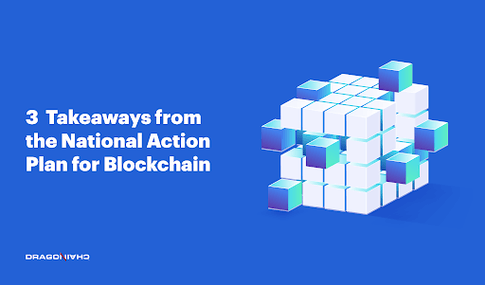3 Takeaways from the National Action Plan and Government Support for Blockchain Technology
In February 2019, the Chamber of Digital Commerce released the National Action Plan for Blockchain, which outlines the ways in which legislators and government agencies can support the growth of blockchain technology.
This document is more than just a push for blockchain implementation and the acceptance of digital assets, it is a roadmap with concrete action items that help achieve these objectives. As a product of the world’s largest blockchain trade organization, the National Action Plan sets a high standard for blockchain advocacy, but you can easily adopt some of its strategies when presenting the value of blockchain to your peers and clients.
Accessibility
No matter how extensively you cover the benefits of your blockchain product or solution, your messaging will not have much of an effect if these benefits are only understood by a small audience. Though details like transactions per second, transaction cost and token classification can be useful for the purposes of differentiation, they are also features that are lost on many potential clients. Like the National Action Plan, you should use language that is detailed enough to capture the unique advantages of blockchain while also being legible to entry-level users and those outside of the community.
Finding a balance between technical and non-technical language takes effort, but it is crucial for customer engagement and buy-in. If you use too little technical language, audiences will not see how blockchain differs from what they already have, but use too much and they will get lost. Whenever possible, do your research on who you will be presenting to and try to speak in the terms they are familiar with, whether that’s operating costs and ROI or smart contracts and consensus mechanisms.
Call to Action
A common pitfall in blockchain discussions is overwhelming someone with details on what blockchain can do, while forgetting to address what they can do with blockchain. This may sound like semantics, but it is just as important to explain the experiential side of blockchain as it to explain blockchain capabilities. As an example, someone can fully understand the technological implications of having 5 second fixed blocks, but it does not necessarily mean they will see the value of such a feature. Any time you introduce someone to blockchain, your goal should be to put them in an active role, thinking up solutions and potential uses, rather than a passive role where they are only absorbing facts.
In terms of blockchain adoption, it is not enough to show someone the “how”; to convert a potential customer or blockchain enthusiast, you must also show them the “why”. This is a point that the Chamber of Digital Commerce handles very effectively, not only telling government officials how to feel about blockchain, but what to do in order to support it. It takes an extra step to put someone in the shoes of a user, but doing so is often the deciding factor in their conversion process; once they have an idea of how they might implement blockchain, they’ll often do the rest.
Targeted Information and Use Cases
Anyone that’s spent any amount of time in the blockchain community knows just how expansive it is from both a technological and business standpoint. The amount of informational material available in the space increases as blockchain companies, use cases, and solutions are introduced into the market. These developments are accompanied by articles, podcasts, and videos, which are helpful to those already in the field, but only add to the mountain of content a prospective newcomer needs to sift through.
As someone trying to communicate the benefits of blockchain, your objective is to pull out the most relevant and noteworthy use cases for your audience. It only takes one example of a blockchain business or functionality to hook someone in, so it’s important to be selective and realize that the use cases that interest you are not necessarily the ones that will interest a client. The National Action Plan provides a good example of this in practice, focusing on blockchain implementations in cybersecurity, healthcare, and financial services- topics that would interest the government officials it was aimed at. If your use case for blockchain revolves around tokenization, but your client is interested in security, your argument won’t have the desired outcome, no matter how passionate or well-spoken you are in your topic of choice.
Through the National Action Plan, the Chamber of Digital Commerce successfully explained the very technical topic of blockchain technology using tried-and-true methods. Your target audience may not be the US Government, but you can just as easily employ the techniques that brought Chamber of Digital Commerce success. For more tips on pitching your blockchain business or solution, read our newly updated Blockchain Project Planning Guide.
